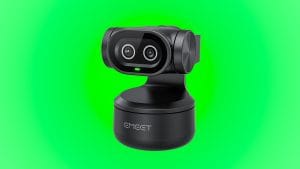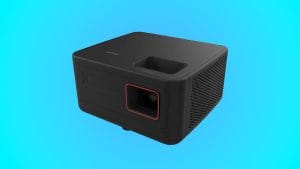SteelSeries Alias Gaming Microphone

design
Realistically there’s only so much you can do with the design of a microphone and given they tend to hide away off camera it’s no surprise many brands don’t spend too long worrying about aesthetics. SteelSeries has gone the other way with the Alias and Alias Pro microphone though, from a purely visual perspective this is a nicely considered microphone with enough little touches to be unique without going over the top for the sake of it.
Mirroring the excellent SteelSeries Arena 7 speakers, the SteelSeries Alias is rounded off at every opportunity. The result is a sleek black pill that I have to admit I quite like, it’s a charming little thing. For a £179 microphone there’s a disappointing lack of metal finish in the construction though, the entire body and stand are plastic and while it doesn’t feel cheap it’s it lacks a luxury edge as a result. It’s the same problem I have with the design of the considerably more expensive SteelSeries Alias Pro, even the thinnest of metal sheets here would have made a huge difference. The face of the microphone is covered in a pleasant fabric that delivers that premium, studio vibe as does the matte grey metal shock mount.
Breaking up the fabric is a panel housing the touch sensitive mute button and a headphone gain dial, with a second dial for controlling mic levels hiding around the back. While OK where they are, for me they’d have been better placed the other way around. The mute button lines up almost perfectly with the wrapped around arms of the shock mount and it all gets a bit cramped. I’m less likely to need to make quick headphone adjustments compared to a quick mute on the fly so the less obstacles in the area the better.
Just like the SteelSeries Alias microphone itself, the included stand is a bit of a looker and has clearly had some time spent on its design style. The curves continue here to create a perfect match for the Alias and Alias Pro, it definitely looks a part of the family. Again it’s all plastic but a wide footprint and weighted, rubberised base meant the SteelSeries Alias happily stayed put and never toppled over even in some of the more extreme angled positions. Sadly while there’s a pretty wide range of tilt angle, there’s no option to rotate or horizontally mount the Alias so you’re stuck with having it stood upright. It’s not outrageously tall, but it was tall enough on the stand to always overlap the bottom of my monitor.

If you want to do away with the stand entirely then SteelSeries includes an adapter in the box that’ll make the Alias compatible with just about any microphone arm. I tested it with both the Elgato Wave Arm and RODE PSA-1 and neither had any problems at all. Even with the shock mount the SteelSeries Alias still only weighs in at just over 200g so even lower-end mic arms should be fine.
It couldn’t be a bit of gamer gear without some RGB flair but on the SteelSeries Alias that’s limited to just a small ring on the bottom of the microphone body. At first glance it may seem underwhelming and when hanging off a mic arm it certainly doesn’t offer much. If you’ve got the Alias perched on its included stand however that little ring sets the whole base underneath glowing. It’s subtle but pleasantly classy, something you don’t often say about gamer RGB.
The SteelSeries Alias has one other trick that’s literally hidden up its fabric sleeve. A row of three green, one yellow and one red LEDs reveal themselves from underneath the surface, offering a real time view of your volume levels. While this is handy to make sure you’re not peaking, after the initial setup it’s more a cool thing than a super helpful one. Tap the mute button however and a far more useful feature emerges, a big, scary red X makes it clear you’re muted. It’s bold, obnoxious and hard to miss so there’ll be no more accidental silent streams or Zoom meeting mishaps.
performance
It’s a bold move to make your microphone debut at a more premium price point, it leaves you without much wiggle room in terms of delivering the goods. Thankfully for SteelSeries however, the Alias sounds great.
There’s a large condenser capsule inside the SteelSeries Alias and the choice to go this way rather than the dynamic route aligns with their gaming focus for this mic. Where a dynamic microphone might offer more of a broadcast vibe, it also requires a lot more microphone etiquette to achieve those results. Meanwhile the Alias’ one-inch condenser capsule picks up sound from a wider area so will be more forgiving to streamers more focused on their game than their microphone.
In testing I felt the cardioid pickup pattern did a good job at maintaining consistent quality from a sizeable bubble in front of the Alias. Moving left and right around the face remained largely similar and it wasn’t until I was particularly below or past the front of the SteelSeries Alias that things started to fall away. It’s still worth trying to remain vigilant though as things sound their best when you’re around 8-10 inches away, my voice became smoother and with more depth.

It’s admirable that SteelSeries have included the same capsule in the Alias as you’ll find in the more expensive SteelSeries Alias Pro. So often USB microphones are left with a lesser option compared with their XLR counterparts. The result is a microphone that delivers clean, detailed sound straight out of the box. I was impressed with how strong the vocal performance was, I sounded natural and clear from the get go.
SteelSeries shared with me how much effort had gone into the Alias’ included shock mount and the results seriously pay off. The cobweb of elastic cables shielded the microphone from desk vibrations and knocks which were rarely pushed through to the final audio.
Realistically most creators, and certainly gamers just looking for clear voice chat, could just run the SteelSeries Alias as is and without messing around with EQ settings. For those who do want to fiddle around though there’s gains to be had by diving into the Sonar section of SteelSeries’ GG software. Here you’ll find a range of EQ options with presets to get you started and the ability to customise them to tune the perfect sound. The click and drag interface is simple to use and having spent a few minutes in there when I first connected the microphone I haven’t needed to go back.
The GG Sonar app also unlocks SteelSeries’ ClearCast AI noise cancellation and it does a wonderful job of binning off unwanted background noise. Just like NVIDIA Broadcast it’s a magically AI powered solution that intelligently filters out distractions without impacting on the quality of my voice. I’m always a little dubious about noise cancellation for microphones, so often it has a negative impact on quality that outweighs the benefits but I left ClearCast on around 50% and was pleased with the results. If you’re streaming from a less than optimal space or have an overbearingly loud mechanical keyboard it’s a real winner – and unlike NVIDIA’s solution it’s CPU driven so shouldn’t impact gameplay too much either.
SteelSeries GG also allows control of your audio output with personal and stream sub-mixes and individual app routing. Having used it for a few weeks I’m still not sure about it. Just like similar offerings from RODE or BEACN it’s great when it works and wildly frustrating when it doesn’t. It’s largely a nicer interface for Windows’ audio management so some of the quirks and limitations fall on Microsoft rather than SteelSeries but that doesn’t make them any less annoying day to day. It’s just a little too keen to be in control, there’s a very specific configuration the software wants you to use and if you’d like a setup that’s different to that be prepared for an argument. You aren’t forced into using it though and can largely ignore it if you don’t want to start dividing up your audio channels.
summed up
The SteelSeries Alias is an impressive USB microphone and as a first attempt from SteelSeries it’s a great start. This isn’t just a re-skinned generic microphone they’ve slapped a logo on, there’s a clear amount of thought and care gone into creating a microphone that will deliver above average results for a USB mic.
Streamers will enjoy the high quality, clean audio with simple control over EQ while gamers will be freed up by the wide pickup area that large condenser capsule offers. £179/$179 makes this a premium level option but it’s a worthy investment with performance that matches the price point.













